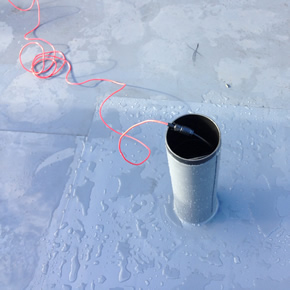
ILD waterproofing detection system provides flat roof reassurance
Designed to alert building owners to flat roof leakage and ingress, the International Leak Detection (ILD) waterproofing integrity testing system has provided reassurance for two decades. Sika finds out more…
Flat roof design has many advantages: it can result in lower building costs, and allows for potential development. The space can be transformed into a Solar or Green Roof, for example.
However, flat roofs are more prone to water ingress than pitched roofs, which can quickly shed waste water by design. Many designers, building owners, facilities managers and tenants fear leakage, which can be costly to combat.
ILD waterproofing integrity testing
In 1996, the International Leak Detection (ILD) was founded to solve this issue. As a waterproofing integrity testing system, ILD involves a trio of techniques.
The first, Electric Field Vector Mapping (EFVM) testing, is carried out by applying water on the surface of a roofing membrane to create an electric field. The water is then used a conductive medium; any breaches in the membrane will cause an electrical connection to occur.
ILD inspectors are able to follow the directional current of the flow to establish its point of entry.
The second technique, ProtectSys ‘B’, comprises an electro-conductive material, contact plates and contact boxes. The system is placed beneath the waterproofing membrane; should any moisture enter into its level, it will be able to determine the location of the defect.
ILD’s ProtectSys ‘WM’ early warning system utilises radio signals to measure temperature and relative humidity inside and outside a roof’s insulation layer. The measurements are transmitted to a central unit via radio signals; they are then mailed to a central computer by G.S.M, where the condition of the roof is analysed.
ILD has been guaranteed as a fault detection system: although there can be no absolute assurances against water ingress with flat roofs, ILD can prevent minor problems from developing further.
The Leak Detection application process
 The specified vapour barrier should be laid according to instructions; insulation boards should then be fitted onto the surface of the vapour barrier.
The specified vapour barrier should be laid according to instructions; insulation boards should then be fitted onto the surface of the vapour barrier.
The non-woven glass fleece should then be loose laid to the upper surface of the insulation boards, before the two contact plates can be fitted into the individual roof area (additional contact plates are required when the roof space exceed 1,500 square metres).
Contractors should then install two cable access duct components as close to the contact plates as possible. The contact plate cable must be brought up through the proprietary cable access duct component to allow the testing ILD technician access.
The single ply roofing membrane can then be fitted to the surface of the insulation boards.
Sika-Trocal,
Watchmead,
Welwyn Garden City,
Hertfordshire,
AL7 1BQ,
United Kingdom
Phone: 01707 394444
Fax: 01707 329129
Visit Supplier's page
Latest news

18th April 2024
Abloy UK showcases new digital portfolio at The Security Event 2024
Abloy UK is set to unveil its latest line-up of access control systems at The Security Event 2024, welcoming guests to explore its cutting-edge electromechanical and digital solutions on stand 5/F50.
Posted in Access Control & Door Entry Systems, Architectural Ironmongery, Articles, Building Industry Events, Building Industry News, Building Products & Structures, Building Services, Doors, Exhibitions and Conferences, Facility Management & Building Services, Health & Safety, Information Technology, Retrofit & Renovation, Security and Fire Protection
18th April 2024
Strand is a Failsafe Choice for Emergency Exit and Panic Hardware
In times of emergency, you’re in safe hands with Strand Hardware. Although there are many considerations for building specification, few decisions can be as critical as selecting the right emergency exit/panic hardware.
Posted in Access Control & Door Entry Systems, Architectural Ironmongery, Articles, Building Industry News, Building Products & Structures, Building Services, Doors, Facility Management & Building Services, Health & Safety, Restoration & Refurbishment, Retrofit & Renovation, Security and Fire Protection
18th April 2024
MRA appoints Callum Budd as Research Projects Director
MRA Research, the research agency focused solely on the construction sector, welcomes Callum Budd as its new Research Projects Director.
Posted in Articles, Building Industry News, Information Technology, news, Recruitment, Research & Materials Testing
16th April 2024
Mitsubishi Electric set to host CIBSE Journal webinar
Mitsubishi Electric will host a CIBSE Journal webinar on Wednesday 24th April 2024 at 1pm to discuss the legislation and initiatives driving changes in the way we will need to heat, cool and ventilate large commercial buildings to reach net zero emissions in the UK.
Posted in Air Conditioning, Articles, Building Industry Events, Building Industry News, Building Products & Structures, Building Regulations & Accreditations, Building Services, Facility Management & Building Services, Heating Systems, Controls and Management, Heating, Ventilation and Air Conditioning - HVAC, Information Technology, Pipes & Fittings, Plumbing, Seminars, Sustainability & Energy Efficiency, Training
 Sign up:
Sign up: